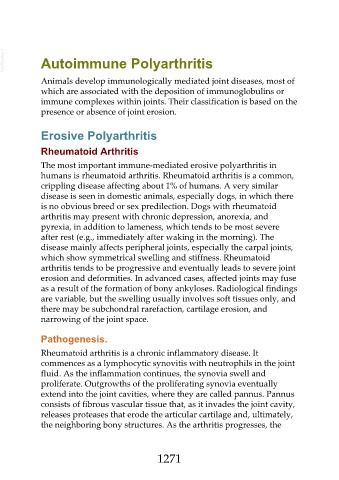Page 1271 - Veterinary Immunology, 10th Edition
P. 1271
VetBooks.ir Autoimmune Polyarthritis
Animals develop immunologically mediated joint diseases, most of
which are associated with the deposition of immunoglobulins or
immune complexes within joints. Their classification is based on the
presence or absence of joint erosion.
Erosive Polyarthritis
Rheumatoid Arthritis
The most important immune-mediated erosive polyarthritis in
humans is rheumatoid arthritis. Rheumatoid arthritis is a common,
crippling disease affecting about 1% of humans. A very similar
disease is seen in domestic animals, especially dogs, in which there
is no obvious breed or sex predilection. Dogs with rheumatoid
arthritis may present with chronic depression, anorexia, and
pyrexia, in addition to lameness, which tends to be most severe
after rest (e.g., immediately after waking in the morning). The
disease mainly affects peripheral joints, especially the carpal joints,
which show symmetrical swelling and stiffness. Rheumatoid
arthritis tends to be progressive and eventually leads to severe joint
erosion and deformities. In advanced cases, affected joints may fuse
as a result of the formation of bony ankyloses. Radiological findings
are variable, but the swelling usually involves soft tissues only, and
there may be subchondral rarefaction, cartilage erosion, and
narrowing of the joint space.
Pathogenesis.
Rheumatoid arthritis is a chronic inflammatory disease. It
commences as a lymphocytic synovitis with neutrophils in the joint
fluid. As the inflammation continues, the synovia swell and
proliferate. Outgrowths of the proliferating synovia eventually
extend into the joint cavities, where they are called pannus. Pannus
consists of fibrous vascular tissue that, as it invades the joint cavity,
releases proteases that erode the articular cartilage and, ultimately,
the neighboring bony structures. As the arthritis progresses, the
1271

